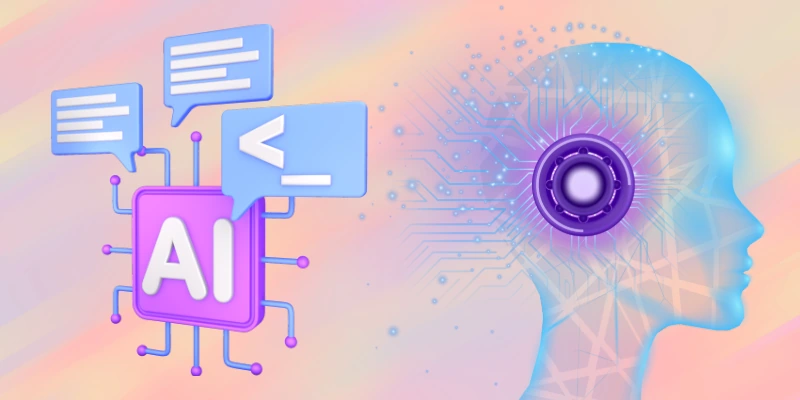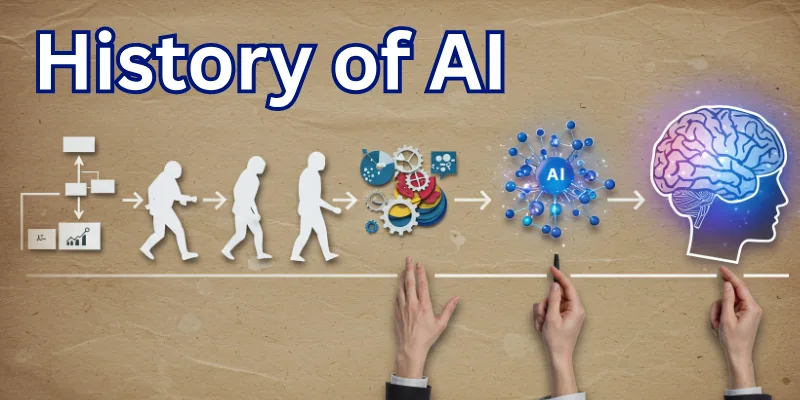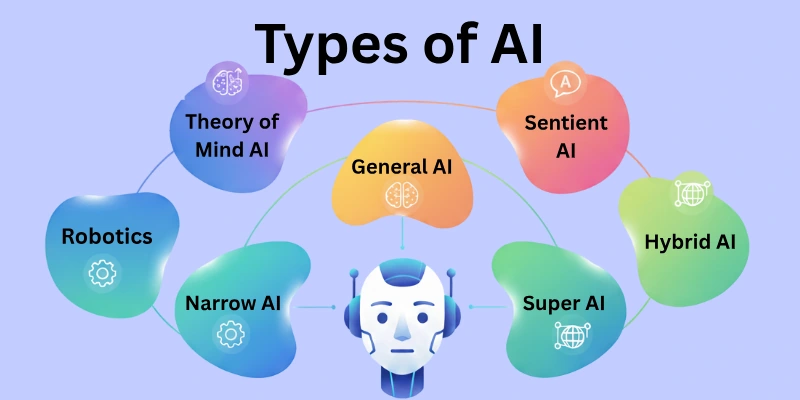What is AI? History, How It Works, & Its Future
Published: 18 Aug 2025
Have you ever chatted with a computer and felt like a real person? That’s the power of AI! AI, which stands for Artificial Intelligence!

It is all around us these days, like ChatGPT and Google’s Gemini, which can understand and generate human-like text. So, guys, in this article, we will explore what AI is, how it works, its various types, how it is used in everyday life, and much more!
So buckle up and get ready to dive in!
What is AI?
Artificial Intelligence (AI) is a type of computer technology that allows machines to think and learn like humans. It uses algorithms and data to make decisions, solve problems, and perform tasks that usually need human intelligence, such as understanding language, recognizing images, and making recommendations.
For example, ChatGPT and Google’s Bard can answer your questions and have conversations with you. Siri and Alexa are AI assistants that help you with tasks like setting reminders and playing music. AI makes these tools smart and useful in our daily lives.
Historical Background of AI
Artificial Intelligence (AI) has a long history. It began in the 1950s when scientists first dreamed of making machines that could think. British mathematician Alan Turing was one of the first to suggest that machines could be intelligent.

In the 1956 Dartmouth Conference, led by John McCarthy, the term “Artificial Intelligence” was created, and researchers started developing early AI programs. Over the years, AI has grown with better computers and more data. Today, AI is used in many areas, like smartphones, healthcare, and cars, making our lives easier and more connected.
How Does AI Work?
AI works by using computer programs that can learn from data and make decisions. The core concepts of AI include:
- Data: AI systems need lots of information, called data, to learn and make smart decisions.
- Algorithms: These are step-by-step instructions that tell the AI how to learn from data.
- Training: AI is trained by feeding it data, allowing it to recognize patterns and improve over time.
- Inference: Once trained, AI can make predictions or decisions based on new data it hasn’t seen before.
In short, AI uses data and algorithms to learn, get better, and solve problems like a human would.
Technical Aspects of AI
AI is a broad area that includes many different ways to make machines smart. To do this, certain methods are used, such as:
- Machine Learning
- Neural Networks
- Deep Learning
So, what does each subset of AI mean? Let’s discover.
1. Machine Learning (ML)
ML is like teaching a computer by showing it examples. It learns patterns from these examples and gets better with more examples. For instance, if you show pictures of cats and dogs, it will learn to tell them apart.
2. Neural Networks
Think of neural networks as computer brains inspired by how our brains work. They’re made of layers of connected nodes, like our brain cells. These networks help computers understand things like pictures and words.
3. Deep Learning
This is a type of ML that uses many layers in neural networks. It’s really good at solving tough problems, like recognizing faces or understanding what people say. It’s like learning many layers of information, which helps the computer understand things better.
Types of AI
Essentially, we classify the various forms of AI into three primary categories. We classify AI based on its capabilities, behaviour, and various other types. Here is a detailed list of all the different types of artificial intelligence:

1. Based on Capabilities
- Artificial Narrow Intelligence (ANI) – Weak
- Artificial General Intelligence (AGI)
- Artificial Super Intelligence (ASI) – Strong
- Machine Learning
- Deep Learning
2. Based on Behaviour
- Reactive Machines
- Limited Memory Machines
- Theory of Mind AI
- Self-Aware AI
3. Other Types
- Natural Language Processing (NLP)
- Computer Vision
- Robotics
- Expert Systems
- Swarm Intelligence
- Sentient AI
- Embodied AI
- Hybrid AI
- Augmented Intelligence (AI working alongside human intelligence)
- Explainable AI (XAI)
- Evolutionary Algorithms
Applications of AI
Every aspect of your life uses artificial intelligence. From home chores to offices, artificial intelligence has significantly evolved. There is no doubt that AI has made our lives easier, and we can handle complex tasks with ease and accuracy. Here’s a brief overview of the applications of AI:
- Virtual Assistants: AI-powered helpers like Siri or Alexa that answer questions and perform tasks for you.
- Image Recognition: AI that can identify objects or people in pictures, like in photo apps or security cameras.
- Natural Language Processing (NLP): AI that understands and processes human language, used in chatbots and translation services.
- Recommendation Systems: AI that suggests products or content based on your preferences, seen in Netflix recommendations or Amazon product suggestions.
- Autonomous Vehicles: Self-driving cars that use AI to navigate roads and make decisions.
- Healthcare Diagnosis: AI that helps doctors diagnose diseases from medical images or patient data.
- Fraud Detection: AI that identifies suspicious activities in banking or online transactions.
- Gaming: AI that plays games against humans or other AI opponents, like in chess or video games.
- Predictive Analytics: AI that forecasts trends or outcomes based on historical data, used in weather forecasting or stock market predictions.
- Robotics: AI that controls robots to perform tasks like manufacturing or surgery.
- Personalization: AI that customizes experiences based on individual preferences, such as personalized news feeds or music playlists.
- Language Translation: AI that translates text or speech from one language to another, like Google Translate.
- Virtual Reality (VR) and Augmented Reality (AR): AI that enhances virtual or augmented environments, providing immersive experiences.
- Energy Management: AI that optimizes energy usage in buildings or power grids for efficiency.
- Content Creation: AI that generates content like articles, music, or art, such as AI-generated paintings or writing assistants like ChatGPT.
Pros & Cons of AI
Here are some major benefits and some limitations of using AI.
Advantages of AI
- Efficiency: AI can do tasks faster than humans.
- Accuracy: AI can make fewer mistakes, especially in data analysis.
- 24/7 Availability: AI can work all day and night without getting tired.
- Personalization: AI can tailor recommendations based on individual preferences, like in Netflix or Amazon.
- Automation: AI can handle repetitive tasks, freeing up time for more important work.
Disadvantages of AI
- Job Loss: AI can replace human jobs, leading to unemployment.
- Bias: AI can learn and repeat unfair biases from its data.
- Privacy: AI needs a lot of personal data, which can lead to privacy issues.
- Dependence: Relying too much on AI can make people less skilled at certain tasks.
- Security: AI systems can be hacked or misused, leading to potential risks.
Ethical and Social Implications
While AI offers many benefits, it also presents significant ethical and social challenges that require attention to ensure fair, safe, and responsible use. So let’s break down some major ethical and social implications:
- Bias and Fairness: Sometimes, AI can learn unfair ideas from the information it uses, which can make its decisions biased. For example, if it learns from data that’s unfair to certain groups, it might treat those groups unfairly too.
- Privacy Concerns: AI often needs lots of personal information to work well, which can make people worry about their privacy. For instance, if AI watches people without them knowing, it might invade their privacy.
- Job Displacement: As AI gets better at doing tasks, some people might lose their jobs because machines can do the work instead. For example, if robots start doing jobs that people used to do, those people might not have work anymore.
- Autonomous Decision-Making: When AI makes important decisions without people’s help, it raises questions about whether it’s doing the right thing. For example, if AI decides who goes to jail or even decides to use weapons, people might worry that it could make mistakes or unfair choices.
Future of AI
AI is still young, but it’s growing fast! Let’s explore what the future might hold:
- Technological Advancements: In the future, AI will get better and more advanced. New technologies will make AI smarter, allowing it to do things like understand speech and recognize images even better.
- Potential Societal Changes: AI will change many parts of our lives. It could help doctors find diseases, make self-driving cars safer, and improve our gadgets and apps. AI will make everyday tasks easier and more efficient.
- Regulation and Governance: As AI becomes more common, we need rules to use it safely. Governments are making laws to protect privacy and ensure fairness. Countries need to work together to create consistent rules because AI affects everyone.
Conclusion
So, guys, in this article we have covered our main topic, “What is Artificial Intelligence (AI)” in detail, from its definition to its future.
We explored the historical background, technical aspects, various applications, and ethical implications of AI. We also discussed the potential advancements and societal changes that AI may bring. While AI offers many benefits like efficiency and accuracy, it also has its downsides, such as job loss and privacy concerns.
It’s clear that AI will continue to shape our world, so staying informed and engaged in discussions about its impact is important.
FAQs

- Be Respectful
- Stay Relevant
- Stay Positive
- True Feedback
- Encourage Discussion
- Avoid Spamming
- No Fake News
- Don't Copy-Paste
- No Personal Attacks

- Be Respectful
- Stay Relevant
- Stay Positive
- True Feedback
- Encourage Discussion
- Avoid Spamming
- No Fake News
- Don't Copy-Paste
- No Personal Attacks





